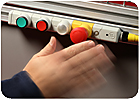
PHOTO: Fortress Interlocks
Even in 2007, violations of OSHA machine safeguarding standards are still all too common. Many companies could benefit from a review of these OSHA regulations. Here’s a synopsis of the standards and some safeguarding tips to help you evaluate your program to see if your safeguards measure up.
The primary, applicable section in the general industry standards is Subpart O (Machinery and Machine Guarding), 1910.212-219. Note, too, that 1910.211 lists definitions and can be quite helpful in discerning which specific standards cover which specific machines.
Use of the word “safeguarding” serves as an important reminder. Protective measures are not limited to conventional “guarding.” Devices other than guards can often be successful in protecting employees. Examples include presence-sensing devices, pull-outs, restraints and two-hand controls.
Standard specifics
1910.212 is invoked by OSHA to address machines for which no other clear safeguarding requirements are delineated elsewhere in the standards. 212 is a sort of catch-all. However, it must not be cited by OSHA as a lazy short-cut to avoid locating and describing a dedicated standard. Some examples of machines cited under 212 include: shears, metal-working lathes, guillotine cutters, milling machines, brake presses, hydraulic presses, slitters, eyelets, multi-slides, and numerous saws used to cut materials other than wood.
There are many other machines cited under this standard, including shop-made and other custom machinery. A distinct part of 212 covers fan blade guarding. Another part covers revolving barrels, containers and drums, and is unusual in its rather specific explanation of required interlocking.
1910.219 addresses power transmission equipment, highlighted by belt drives, chains and sprockets, gears, couplings and shafts. Additional machine safeguarding standards, addressing particular machines, are found in the following areas:
1910.261 (Pulp, paper and paperboard mills)
1910.262 (Textiles)
1910.263 (Bakery equipment)
1910.264 (Laundry machinery and operations)
1910.265 (Sawmills)
1910.266 (Logging operations)
1910.255 (Resistance welding)
Beware of new machines
There seems to be a common assumption that machines will arrive from the distributor or manufacturer with all necessary guards, devices, controls, emergency shutoffs, and so on. Don’t bet on it!
You should be able to increase your confidence level by ensuring that your purchase/lease order includes language indicating that the machine must be in full compliance with standards and good practice, when delivered. You might reference ANSI, as well as OSHA. I highly recommend such language (check with your attorney and/or purchasing agent).
Further, don’t relax simply because the machine is new. If the machine is second-hand, in which case it may have come as a “rebuilt” or similarly designated item from the distributor or manufacturer, or worse, if it has come directly from a company that had it in use (or from a liquidator), you must be extremely careful.
Analyzing equipment
A person need not be an engineer, electrician, mechanical expert, maintenance “superstar,” machine designer or machine operator to recognize where and when machines need safeguarding. To identify hazards when observing the machine, the most critical observations stem from common sense. Although the list can go on and on, I propose a lean, pragmatic and straightforward analysis, which can be utilized whether the person making the evaluation has seen the type of machine previously or not.
The most elemental and significant questions to answer are the following:
1. Where are the moving parts?
2. In which direction(s) do those parts move? (Note: They may move in one direction sometimes and another direction at other times.)
3. At what approximate/relative speed do those parts move?
4. Can a person reasonably be injured as a result of contact with (or caused by) those moving parts? (Note: The simple existence of moving parts does not automatically translate to a violation or a hazard.)
5. Besides moving parts of the machine, are there hazards associated with very hot or very sharp machine surfaces; projecting/flying chips, sparks, liquids, material, parts, etc.; or similar dangers?
6. Where are the user’s hands?
7. Where are the user’s feet?
8. Where are the user’s eyes?
9. Where are the activation, speed control and similar movement-causing/increasing buttons, pedals, levers, etc.?
10. Where are the emergency shutoffs, brakes, reversing mechanisms, etc.?
Never assume
Other machine inspection tips include:
• When inspecting the machine, there is often a need to watch certain operations for a long period of time. It may be too difficult to “catch” all of the action at once. When you first approach a machine, it may be performing a job wherein not all of the sections (moving parts included) are functioning. You should see the machine when everything is moving, or see everything move at one time or another.
• When viewing a non-working machine, do not assume that you fully understand how it operates. There is no substitute for observing a machine in action. Ideally, you should watch maintenance, setup and cleaning operations (in addition to full production) because employees are often subjected to the germane hazards in those situations.
• Never assume that all operators work the machine in the same, step-by-step way. A particular operator, by adding, subtracting or modifying a step, may create or exacerbate a hazard. Do not rely on standard operating procedures or job hazard analyses alone. In “real life,” the business at hand may not be conducted in that ideal manner.